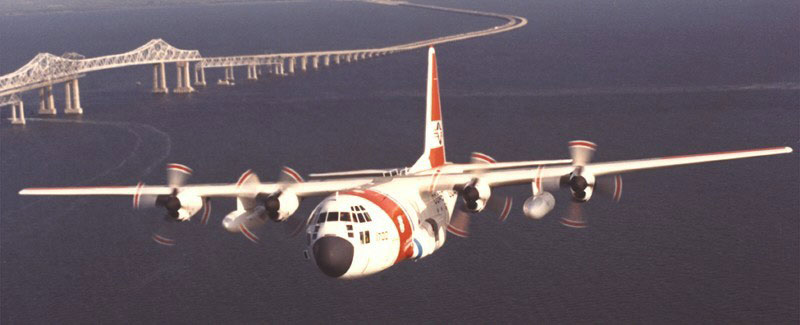
As the C-130 proved successful with the Air Force, other branches of the service began taking a look at the new transport. The United States Coast Guard’s mission of long-range search and rescue and coastal patrols dictated the need for a new airplane and the C-130 HERCULES filled the need. In 1958 the Coast Guard ordered four airplanes, the first of a dozen the service would receive by 1963. Since Lockheed had improved the original C-130 design, the first airplanes delivered to the Coast Guard were C-130Bs
The HERCULES proved ideal for the Coast Guard mission. The airplane’s long range allowed long loiter times while on patrol, a feature that was enhanced by the practice of shutting down the outboard engines to conserve fuel. This capability had been demonstrated in the early days of the C-130 program when a Lockheed crew flew an A-model all the way across the United States at low level with two engines feathered.
The first HC-130H flew on 8 December 1964. This updated version was obtained to primarily perform search and rescue missions. These aircraft also performed tasks related to the U.S. space program. They carried additional equipment and two 1,800-gallon fuel bladders in the cargo compartment. They also had a very unusual and distinctive feature on top of the fuselage, forward of the wing. This large “blister” contained the Cook Electric re-entry tracking system which was used in conjunction with the Gemini spacecraft.
In 1966 the USCG received another version of the HERCULES, a specially configured EC-130E equipped with calibration equipment for the service’s far-flung LORAN stations. In the late sixties and early seventies, the Coast Guard began equipping with the HC-130H, soon after the same version went into service with the USAF.HC-130s can exceed 2,600 nautical miles (4,815km) in low-altitude flight with a mission endurance of up to 14 hours. Inertial Navigation Systems (INS), Omega, Loran-C, Global Positioning System (GPS), radar and guidance aids all enhance the HC-130’s effectiveness during long-range maritime patrols. These aircraft are also equipped with a ten-tube flare launch system. U.S. Coast Guard HC-130s are not capable of refueling other aircraft in flight.
The Lockheed Martin EC-130V AEW&C aircraft was first developed by General Dynamics in 1992 for the United States Coast Guard as a proof-of-concept aircraft. The EC-130V combined a C-130H airframe with the APS-125 Radar and Mission System of the U.S. Navy’s E-2C Hawkeye. This aircraft was primarily used for counter-narcotics missions requiring greater endurance than the E-2C could provide, but also was evaluated for Search and Rescue, Fisheries Patrols, EEZ enforcement and as a support aircraft for NASA Space Shuttle launches.
Externally, the EC-130V differed from a standard Coast Guard C-130 with the fitting of a large rotor-dome housing the APS-125 radar. Internally, the mission system was palletized and rolled into the cargo compartment.
Due to budget cuts, the Coast Guard EC-130V program was terminated and the aircraft was transferred to the USAF as the NC-130H for further development, including upgrading to the latest APS-145 radar.
C-130J aircraft were obtained in 2004 for a logistic support role. They had an enhanced cargo handling system that allowed for rapid conversion from in-floor load tie-downs to rollers for palletized cargo. In 2008 they were upgraded with interoperable mission packages equipping them to function as very effective search and rescue aircraft.
